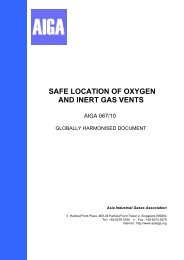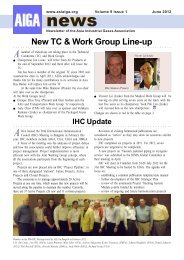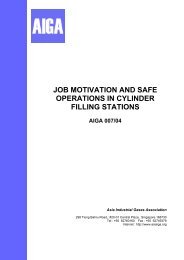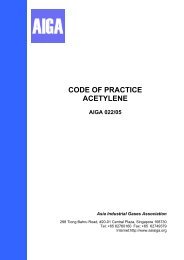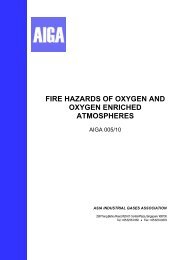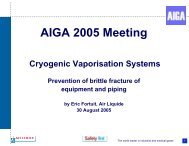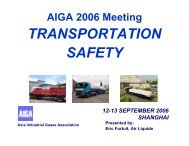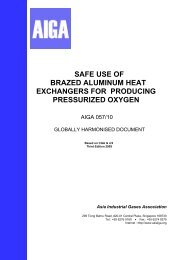CLEANING OF EQUIPMENT FOR OXYGEN SERVICE - AIGA
CLEANING OF EQUIPMENT FOR OXYGEN SERVICE - AIGA
CLEANING OF EQUIPMENT FOR OXYGEN SERVICE - AIGA
You also want an ePaper? Increase the reach of your titles
YUMPU automatically turns print PDFs into web optimized ePapers that Google loves.
10<br />
<strong>AIGA</strong> 012/04<br />
4.2.3.4 Notes on Solvent Cleaning<br />
a) Advice on suitable solvents will be found by reference to Section 3 (Cleaning Materials).<br />
b) Some plastic materials, including polyvinyl chloride (PVC) and poly-methylmetacrylate (PMMA)<br />
should not be used as containers as the plastics can be extracted by the solvent and be<br />
deposited on the component being cleaned. Similarly, rubber and neoprene are also affected.<br />
Therefore, products manufactured from these materials shall not be cleaned with chlorinated<br />
solvents.<br />
Polytetrafluoroethylene (PTFE) is satisfactory for use with chlorinated solvents and is the most<br />
frequently used material. Generally, non-metallic materials require confirmation of acceptability before<br />
use.<br />
4.2.3.5 Health and Safety Precautions - Solvent Cleaning<br />
Solvents are generally toxic and may act on the human body through inhalation, penetration of the<br />
skin and ingestion (see exposure limits for some solvents in Table 1). Some, such as<br />
dichloromethane, trichloroethylene and tetrachloroethylene are classified as suspected to be<br />
carcinogenic.<br />
Solvent cleaning agents shall only be used when their application, performance and health<br />
implications are fully understood and the manufacturer's recommendations are complied with.<br />
1) Vapours from some solvents are a powerful anaesthetic. Inhaled in small quantities it will cause<br />
drowsiness. In large quantities the vapour can cause unconsciousness and fatality. National<br />
regulations provide measures to control use of these products.<br />
Emission to the atmosphere has to be considered and kept to a minimum level and of course in<br />
accordance with legislation.<br />
Care must be taken that adequate ventilation is provided in areas utilised for solvent cleaning to<br />
prevent people breathing excessive amounts of solvent vapour or the products of decomposition.<br />
In solvent cleaning operations outdoors, it may be possible to locate the' working area to keep<br />
people up wind of solvent handling.<br />
Receptacles for the solvent shall not be left in working areas without lids or caps fitted, and shall<br />
be suitably labelled.<br />
To avoid exposure above permitted levels solvents shall not be removed from components by<br />
blowing dry in confined spaces.<br />
2) Some solvents may decompose to form very toxic gases, e.g. phosgene in the presence of heat<br />
sources (> 200°C) or ultra violet rays.<br />
Some mixtures are readily ignited with increased pressure and/or oxygen content.<br />
Most solvent vapours are capable of creating an explosive mixture at certain concentrations with<br />
air or oxygen.<br />
It is important to ensure that parts to be welded or heated shall be totally free of solvent.<br />
Smoking and the performance of any operations involving the use of flame, arcing or other source<br />
of heat higher than 200°C shall be prohibited on premises where vapours of halogenated solvents<br />
are present. Exposure of the solvent to daylight over a prolonged period may also cause<br />
decomposition of the material.<br />
Do not heat solvents above the allowable temperature. This temperature shall be checked with<br />
the solvent supplier or with other relevant information like the Material Safety 0Data Sheets.<br />
Do not use chlorinated solvents for cleaning closed tanks or other elements where it is not<br />
possible to ensure total removal of the solvent.<br />
3) Characteristics of solvents, toxicity, occupational exposure limits etc. will be found by reference to<br />
Section 3 (Cleaning Materials) and Table 1.



